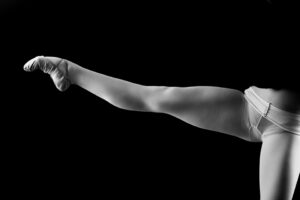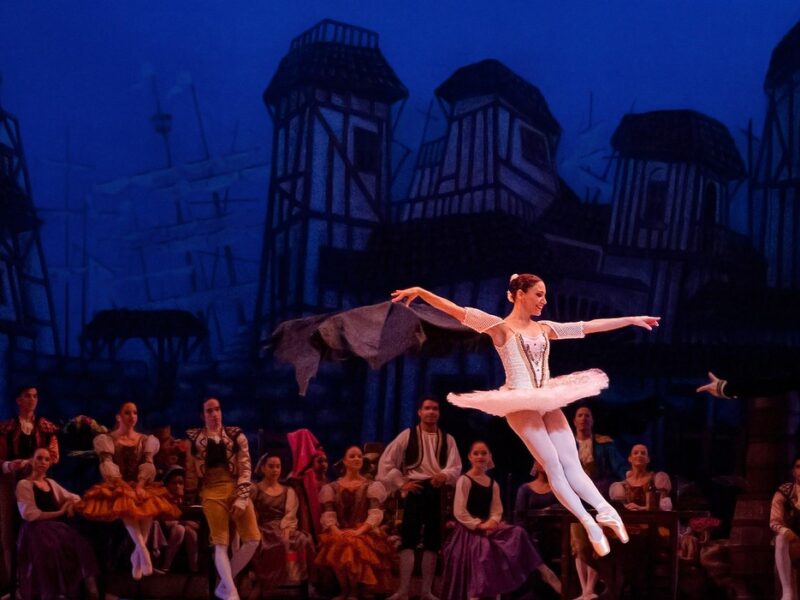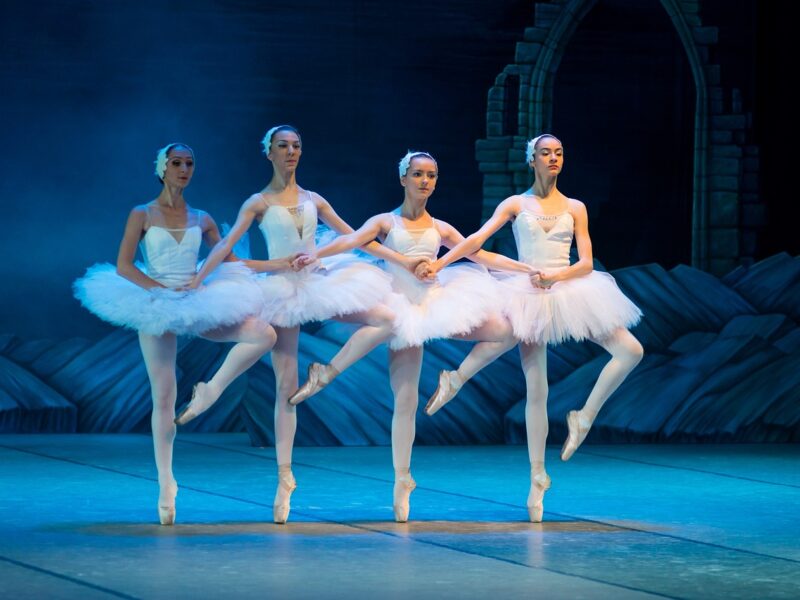Développés up to the skies… some dancers do have ‘em, but we certainly do all want them! From Maria Khoreva to Svetlana Zakharova, more and more dancers are showcasing their incredible extensions and proving that Fonteyn’s 90 degrees are definitely a thing of the past. But how are you going to make your mark on an industry where ballerinas seem to be getting their legs up to new heights every single day? Well, it’s simple… you’re going to do the same!
While some dancers have a natural ability to achieve glorious turn-out or hundreds of pirouettes, the same applies to hip flexion, or in others words the capacity to lift your leg as you développé. Unfortunately, we aren’t all so lucky, however I do have a game-changing secret up my sleeve that I’m willing to share with you…
Okay, so maybe it’s not that much of a secret after all, but it will change your life (and your développés) none the less! Let me introduce you to the iliopsoas, otherwise known as your new bestie, and the key to unlocking the développés of your dreams!
Located in your hip, the iliopsoas is a major hip flexor linking the spine, pelvis and femur, and it is made up of three different muscles: the iliacus, psoas major and psoas minor. Assisted by a strong core and flexible hamstrings, the iliopsoas is responsible for lifting the leg above 90 degrees as you extend.
Unfortunately, a lot of dancers suffer from a tight and weak iliopsoas, which significantly reduces their ability to extend their legs above 90 degrees. A tight iliopsoas is commonly characterised by an anterior pelvic tilt, and this misalignment of the pelvis can again reduce the height of extensions and the dancer’s ability to turn out, potentially leading to conditions such as snapping hip syndrome. If you find that your teacher is constantly telling you to ‘tuck your tail under’, or you struggle to push your belly button into the floor and engage your core during ab exercises, you may be suffering from a tight iliopsoas.
Sounding bleak? I won’t argue that having a tight and weak iliopsoas is hardly ideal, however there really is no need to feel deflated or contemplate giving up! Stretching and strengthening the iliopsoas and core can make a real difference to your alignment, turn out and the height of your développés. Carry on reading to find out how you can achieve the enviable extensions that you’ve been praying for…
In this article, I’m going to take you through some of the best floor barre exercises for strengthening and stretching the iliopsoas. I’m a huge fan of floor barre, and absolutely recommend it for dancers with a weak or tight iliopsoas who are looking to strengthen and find the correct alignment for their développés . Without the added force required to execute movements against the weight and resistance of gravity, all whilst trying to balance on the supporting leg, floor barre allows dancers to improve their alignment, strength and flexibility with little tension being placed on the body!

Exercise #1 – Attitude à la seconde turning in and out
This floor barre exercise is one of my all-time favourites for not only strengthening the iliopsoas (which is used to lift the leg) but also the quadratus femoris (an external rotator) which is used to turn it out as you extend. It’s really important that you learn how to engage both the hip flexors and external rotators when you développé, as simply lifting the leg without turning out from the hip will leave you with a nasty hip hike, which doesn’t make for good technique at all!
Step 1) Lie on your right and bring the left leg into attitude à la seconde.
Step 2) Use the external rotators to turn the left leg out and then in, holding each position for a couple of seconds.
Step 3) As your turn out, bring the left leg towards you as if you are preparing for a high développé to the side. It may help to imagine your iliopsoas contracting and drawing the leg in, while the external rotator turns continues to turn it out.
Step 4) Repeat on the other side.
Exercise #2 – Clamshells
Clamshells are one of my go-to exercises for targeting the gluteus medius, which is responsible for maintaining stability as you développé, and also helps to turn out the working leg as it extends.
Step 1) Lie on your right side with both legs stacked on top of one another. Your legs should bent at a right angle, with your feet in line with your bottom.
Step 2) Lift the left knee as much as possible without rotating the hip, both of your feet should remain in contact.
Step 3) Lower the left leg back to the starting position and then repeat the exercise. As you get tired you may feel your gluteus medius contracting.
Step 4) Repeat on the other side.
Exercise #3 – Hollow body hold
In order to maintain stability and spinal support as they développé, dancers must have impeccable core strength. Hollow body holds are a great compound exercise which can be adapted to target the hip flexors and quads as well as the transversus abdominis (deep muscles) and rectus abdominis (6-pack muscles) of the core.
I would recommend starting with the beginner’s version of the hollow body hold, which solely focuses on the core without placing strain on the hip flexors, before progressing onto the intermediate and advanced versions of the exercise as your abs become strong enough to sustain the movement. Work on holding each position for 30-40 seconds.
Beginner
Step 1) Lie on your back and lift your legs off the floor. Bend your knees at a right angle.
Step 2) Brace the abdominals and lift your head and shoulders off the floor.
Step 3) Reach past the back of your thighs with your arms.
Step 4) Hold for 30-40 seconds.
Intermediate
Step 1) Lie on your back with your legs straight and pointing to the ceiling.
Step 2) Brace the abdominals and lift your head and shoulders off the floor.
Step 3) Reach for the ceiling with your arms.
Step 4) Hold for 30-40 seconds.
Advanced
Step 1) Lie on your back with your legs straight and pointing to the ceiling.
Step 2) Brace the abdominals and lift your head and shoulder off the floor.
Step 3) Reach for the ceiling with your arms.
Step 4) Slowly lower your legs and arms closer to the floor to create a boat/bowl shape. If you feel strain in the hip flexors return to the Intermediate version of the exercise as this means that your core is not yet strong enough to sustain the movement.
Step 5) Hold for 30-40 seconds.
Remember to never neglect the power of breathing when strengthening your core. Before starting an exercise, always breath out as you engage the core to create intra-abdominal pressure. This pressure activates the deep abdominal muscles to provide support to the spine.
Keep working on creating this intra-abdominal pressure until doing so becomes second nature. Before executing a développé, breath out as you engage the core to help support your posture as you perform the movement, especially in the centre when the barre isn’t there to provide stability!
Exercise #4 – Seated Knee Lifts
If you’re still here reading this, I’m guessing it’s because you want to improve the height of your développés . If that’s the aim then look no further than the hip flexors.
Seated knee lifts activate and strengthen the iliopsoas, which is the muscle (or group of muscles) responsible for lifting the leg above 90 degrees. Start off by performing the seated knee lifts with no resistance, and as you gain strength in the hip flexors, try pushing down against your knee as you lift it. Alternatively, wrap a resistance band around a chair leg and the knee you are raising.
Step 1) Sit on a chair with your feet touching the floor. Your knees should be bent at a right angle.
Step 2) Position your trunk into a slight posterior pelvic tilt.
Step 3) Lift the right leg from the hip, aiming for the thigh to touch the chest/abdomen.
Step 4) Hold for 5 seconds before lowering.
Step 5) Repeat.
Exercise #5 – Développé devant with an exercise ball
Floor barre is a super helpful tool for learning how to execute your extensions with the proper technique, without the unwanted resistance of gravity. Using an exercise ball to perform your développés will allow you to experience the sensation of the correct alignment of the pelvis, which can then be transferred to your standing extensions.
Step 1) Lie on your back with an exercise ball under your ankles/calves. Your legs should be straight.
Step 2) Engage your core and push up on to the ball to lift your body as if you are performing a glute bridge with straight legs.
Step 3) Without letting your pelvis drop, perform a développé devant by drawing the right leg to passé before extending it to the front.
Step 4) Lower the leg back to the ball and repeat the exercise.
If your core is weak you might struggle to balance on the exercise ball, and may find that attempting to balance compromises your focus on pelvic alignment. For a less challenging alternative, try placing your feet on a chair or sofa.
Exercise #6 – Développés à la seconde with an exercise ball
When performing extensions, it’s important to always keep the pelvis aligned as opposed to ‘hiking’ the hip of the working leg- even if this does help to improve height! This floor barre exercise is brilliant for learning how to stack the hips to prevent hiking and incorrect form during your développés.
To ensure your hips are aligned correctly, you may want to try placing your hands on your ASIS (the bony structures you can feel if you place your hands on your hips) and watch that these stay stacked and level. Using the exercise ball to retiré the working leg as you prepare to extend will also promote turn out and help to stop the hip from hiking!
Step 1) Lie on your right side and place an exercise ball between your feet. Your legs (particularly the working leg) should be turned out.
Step 2) Retiré the left leg (working leg) to passé by using the left foot to roll the exercise ball up the right leg (supporting leg).
Step 3) Use your hand to hold the exercise ball as you extend the working leg à la seconde.
Step 4) Bring the working leg back to passé and lower it back to the starting position by using the foot to roll the exercise ball back down the right leg.
Exercise #7 – Side développés with mini ball
When performing extensions to the side, dancers often ‘sit’ into the hip of the standing leg, especially during adage in the centre when the barre isn’t there to offer stability.
This is another of my favourite floor barre exercises, where by placing a mini pilates ball under the hip of the standing/supporting leg, dancers are able to experience how the correct pelvic alignment feels, allowing them to then replicate this sensation as they perform extensions while standing.
Step 1) Lie on your right side with a mini pilates ball placed under your right hip. You will need to lift and support your trunk by bending your elbow and placing your weight on your forearm.
Step 2) Perform a développé à la seconde with your left leg. The pilates ball should stop you from sitting into your right hip.
Step 3) Repeat.
Exercise #8 – Hamstring Resistance Band Stretch
You may have the world’s strongest hip flexors, however if you are lacking in hamstring flexibility then it’s very unlikely that you will be able to achieve an extension above 90 degrees. There are many hamstring stretches which will help free your legs so that they may soar to great heights, however this is one of my favourites…
Step 1) Sit with one leg extended out in front of you.
Step 2) Place a resistance band around the ball of the foot of the extended leg.
Step 3) Use your arms to pull the resistance band towards you until you feel a stretch in your hamstring.
Step 4) Hold for 30 seconds.
Final thoughts on Floor Barre for Higher Développés
Dancers are known to be impatient when it comes to strengthening exercises, and often feel deflated or disappointed when they don’t see immediate results. If I can give you one piece of advice let it be this… DO NOT GIVE UP!!!
Strengthening and stretching your muscles takes time, and you’re very unlikely to see any results within a week or even a month! But what’s the alternative? If you do get bored and give up then your extensions will never get higher, but if you keep at it and put in the hard work then you will eventually be rewarded with the incredible legs you’ve always dreamt of!
If you’re still wanting more, go and check out my article How to improve leg extensions (développé devant) for more of the best top tips and exercises to help your développés soar to new heights!
**FRIENDLY DISCLAIMER: All information, guidance or advice provided on this site is for informational and educational purposes only. The use of this information is at your own risk. **

